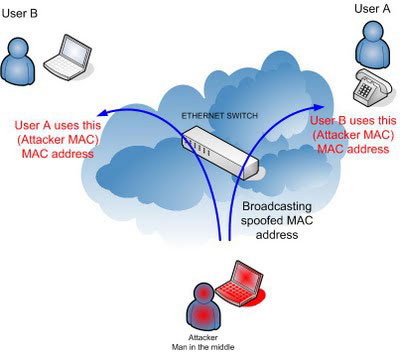| Contents | ||||||||||||
| Introduction | ||||||||||||
| In the previous article "Tutorial on Basics of NIC, MAC and ARP" [Reference 1], I wrote about some of the basic network terms NIC, IP Address, MAC & ARP etc. | ||||||||||||
 |
||||||||||||
| Here I will explain in depth about ARP Spoofing, how it can be used to perform local sniffing and possible solutions to protect against such attacks. | ||||||||||||
| ARP Spoofing/Flooding/Poisoning | ||||||||||||
| ARP Spoofing is one of the predominent
attacks executed in local network. This attack involves sending fake or
spoofed ARP messages onto a LAN. It is possible to update a host's ARP cache with false information via spoofed ARP Replies. This technique is known as 'ARP Poisoning' and is the basis of more complex attacks. The most dangerous amongst them is Sniffing . Poisoning can also help in causing DoS type of attack too but here we will primilarly focus on Sniffing the network data. Sniffing is the term used to describe the reading of all packets on a network segment. This is relatively easy on a network connected via a hub as ethernet is a broadcast medium and the attacker would only have to place his NIC in promiscuous mode to 'sniff' all traffic on that network segment. In a switched network this is not possible. This is because a switch builds a table of MAC addresses and their associated ports when the switch is powered on. When a host transmits an ethernet frame the switch examines the destination MAC address and routes the frame to the associated port as given in the switch table. Therefore it is not possible to sniff any traffic on the network. There are two methods to sniff traffic in a switched environment using ARP Poisoning. The first is for the attacker to send flood of spoofed ARP Replies to the switch. The switch will process these replies, updating its routing table. If this is done at a rapid rate the switches table will overflow and the switch will default to broadcast all traffic to all ports like Hub. The attacker can now 'sniff' all network traffic. |
||||||||||||
 |
||||||||||||
| The second method involves a 'man in the
middle' (MITM) style attack. I will explain this technique in detail by
aid of an example. Below is a simple network segment with three hosts in
a switched environment. The attacker wishes to sniff all traffic that A sends to B and visa versa. This is currently not possible as the attacker is connected to the network via a switch. The correct IP addresses and MAC addresses for each host are as follows: |
||||||||||||
|
||||||||||||
| Firstly the Attacker will poison A's ARP cache with a spoofed ARP Reply. The ARP reply will tell A that the IP address of B now has a MAC address of 00:00:00:00:00:04. Once A has processed the ARP Reply its ARP cache will look like this: | ||||||||||||
|
||||||||||||
| Secondly the Attacker will poison B's ARP cache with a spoofed ARP Reply. The ARP reply will tell B that the IP address of A now has a MAC address of 00:00:00:00:00:04. Once B has processed the ARP Reply its ARP cache will look like this: | ||||||||||||
|
||||||||||||
| Now whenever A sends B an ethernet frame the switch will route it to
the attackers port, this will also be the case whenever B sends A an
ethernet frame. The attacker may now 'sniff' the traffic whilst
forwarding it on to its originally desired host. The thing to keep in mind here is that the attacker must perform the two way poisoning so that it can recieve the packets as well as send it to the destination. In this way the connection will always be alive between the two communicating hosts and the attack will perform successfully. |
||||||||||||
| Detection & Mitigation | ||||||||||||
| One of the solution to prevent ARP cache
from being poisoned there by protect against ARP Spoofing, is to add
static IP-MAC entries to the cache. If an ARP cache has been made static
it will not process any ARP Replies received unlike a dynamic ARP cache.
However this is not practical for large networks as the correct IP address to MAC address association of every host would have to be present in the cache of every host before it is made static. If one host changed its MAC address (e.g. after replacing a NIC) all hosts ARP caches would need to be updated manually. On windows, a login script could automate this process however it has been reported Windows will still accept and process ARP Replies even when the ARP cache has been made static. Other solution, is to use Intrusion Detection Systems (IDS) to detect ARP Poisoning attacks. You can also use tool, ArpWatch [Reference 2] to monitor against such ARP spoofing attacks on the local network. | ||||||||||||
| ARP Spoofing Demonstration | ||||||||||||
| Here is very good flash demonstration (obtained from oxid) which will help you to understand entire 'ARP Spoofing' operation. | ||||||||||||
| http://www.securityxploded.com/arp-spoofing.swf | ||||||||||||
| References | ||||||||||||
| Conclusion | ||||||||||||
| Hope this tutorial has helped to clear out the basics of ARP Spoofing, its attack vector and possible way to detect/mitigate such attacks. |
Wednesday, 29 February 2012
Labels:
news
Subscribe to:
Post Comments (Atom)
No comments:
Post a Comment